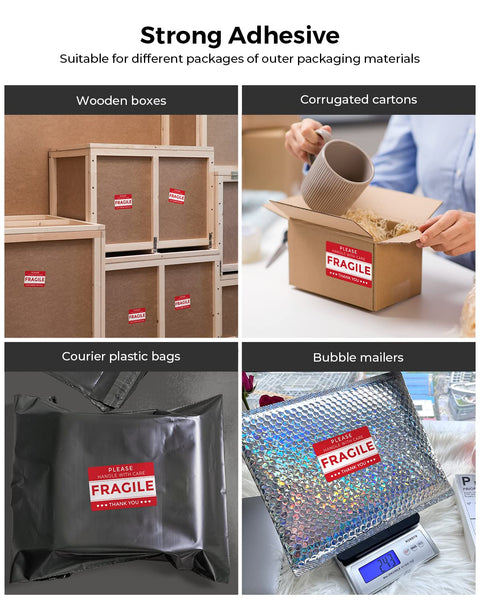How to Ship Fragile Items: A Guide for Small Businesses

Selling things online can be tricky because there's a higher chance that stuff might get broken. This can be a big problem for sellers, but it's just part of the deal when you run an online store. Sending things in the mail can already be tough, and when you have delicate items, it makes things even trickier.
Studies have found that 34% of items that get sent back because of problems with the packaging are actually because the product got damaged. So, when you're dealing with fragile items, you need to be super careful. If you're not, you might end up losing money because your items break while they're being shipped. This article will give you tips on how to ship delicate items so they don't get damaged during shipping and so your customers stay happy.
What are fragile items?
Now, since we’ve been talking about fragile items, I’m sure what you have in mind are glass and porcelain. But that’s not all. Fragile items refer to anything that can easily break or shatter. That could range from ceramics to glassware and sometimes musical instruments.
Also, most technological devices fall under the ‘fragile items’ category as they can break just from excessive shaking. In this section, I’ll share with you a list of delicate things that will appreciate extra tender loving care during packaging. That includes;
- Artwork
- Mirrors
- Antiques
- Handmade Ceramic items
- Glassware
And since there are specific regulations about shipping fragile items, take time to learn if there are special regulations from the package origin and destination. You might also consider getting insurance, especially if you’re shipping items overseas. That helps minimize risk and generally gives you peace of mind.
The importance of cautious shipping for fragile items
Undoubtedly, broken products cost a lot of money, potentially reducing your overall profit.
Cost of returns
One main reason you need to be cautious when dealing with fragile items is the reshipment of an undamaged item. When trying to resolve a damaged shipment order, you will have to settle the complaint with an undamaged one.
In such a case, where you have to deal with the return of a damaged item, someone will have to pay for that return shipping label. More importantly, if your return policy states that you offer free returns, that will incur extra costs for your business.
On the other hand, if the customer has to pay for the shipping of returned items, they’ll end up frustrated. That could easily lead to negative feedback and experience. Be prepared for a backlash from your customers.
Negative Reviews
When customers are excited to get their item only to find out that it’s broken, they’ll likely leave a negative review. Even if you cover all costs and send a new one as soon as possible, the customer will already be frustrated with the experience. For that reason, there’s still a high chance they could negatively rate your business. However, you could try to give a free product or a discount on the next order to at least soften the customer’s heart.
Lost Business
Unfortunately, not all customers are willing to wait for a new product. More often than not, customers will simply request a refund and avoid purchasing from your brand ever again. That’s how you lose customers because they will now believe that you can’t deliver products in good condition.
And with that, your business will likely suffer a massive sales drop, primarily if you’ve delivered damaged items to many of your customers. Customers will also be compelled to leave feedback explaining they got damaged items which could deter potential customers.
Tips on how to pack fragile items
Shipping fragile items might sound a bit complicated for new eCommerce business owners. But as long as you follow the necessary guidelines, everything is pretty straightforward. With that said, below are some of the best practices for shipping fragile items safely.
Choose the right-sized box
To keep your delicate stuff safe, you need the right-sized box. When picking a box for your fragile things, make sure it can hold the weight and has space for padding.
For the best material, corrugated boxes are a great choice. They're made from strong cardboard, so they're good for shipping fragile items.
Pack safely
Fragile things can easily break, burst, or spill. So, it's important to wrap them up safely with good cushioning materials.
To pack fragile stuff securely, start by putting honeycomb paper around the delicate item. Then, carefully wrap the fragile thing with bubble wrap, which is like a protective, air-filled blanket. To stop things from moving around inside the box, fill any empty spaces with packing peanuts or kraft paper. These materials are perfect for filling gaps in the box so nothing jiggles during shipping.
If the item is super delicate, you can use two boxes and lots of cushioning material for extra protection. The more, the safer!
Make the Bottom Strong
It's crucial to ensure that the bottom of your package is strong and sturdy to prevent any damage to your fragile items during shipping. To achieve this, consider placing a layer of packing peanuts at the bottom of the box. These soft and cushiony peanuts act as a protective barrier, absorbing shock and providing extra support to the contents inside. This simple step helps safeguard your delicate items and minimizes the risk of breakage by reinforcing the package's foundation.
Securely Seal the Box
To keep your fragile items safe, it's essential to tightly seal the box. Use strong packing tape to seal all the edges and seams of the box. By taping every edge securely, you ensure that the box remains closed and provides maximum protection during its journey. This step helps prevent the box from accidentally opening and keeps your delicate items safely enclosed throughout the shipping process.
FedEx offers an infographic detailing the proper way to pack your boxes.
Apply Fragile Shipping Labels
Don't forget to add fragile shipping labels to the box. These labels alert the shipping handlers that the contents are delicate and need special care. Place these labels on the outside of the box, making them easily visible. That way, you are almost guaranteed that the package will remain on the correct side during shipment.
Choosing the best carrier to ship fragile items
Different shipping companies have their own rules for handling delicate items.
UPS: UPS charges an additional fee for taking special care of fragile items and provides sturdy boxes to protect them.The price may vary depend on your location since the stores are owned individually.
USPS: Starting from July 10, 2022, USPS no longer offers a "Special Handling—Fragile" service, making it impossible to pay for extra fragile handling with USPS.
FedEx: FedEx charges at least $13.49 extra per package to handle fragile items with care. Keep in mind that this price doesn't include shipping fee.
It's important to note that most large shipping companies now use machines to sort packages, which means your package may go on a conveyor belt. Even if you label your package as "fragile" and pack it securely, there's still a chance it could get damaged.
To safeguard your fragile items, it's a good idea to purchase additional insurance. This insurance allows you to file a claim if your package gets damaged or lost during transit. This added protection can save both you and your customer money on shipping costs.
Creating a return policy that earns trust
Creating a return policy is an essential step for small business owners, especially when it comes to fragile items. While it might seem tempting to have a no-return policy to avoid revenue loss, many customers hesitate to make a purchase if there's no return option, especially when shopping for fragile items online.
Having a transparent return policy can help customers feel more confident about placing an order, knowing that they'll get their money back if they receive a broken product. It can also build trust in your brand, even if accidents occur during the shipping process, resulting in positive reviews.

That being said, it's crucial to include specific rules in your return policy that protect your business too. If you sell on Etsy, you have the option to set return windows and conditions for eligible returns. Make sure to clearly state if you only accept returns within a specific timeframe. Additionally, make it easy for buyers to contact you with any questions they may have.
By creating a clear and customer-friendly return policy, you'll not only provide peace of mind to your customers, but you'll also safeguard your business.
Secure your shipments with Munbyn
Munbyn provides top-notch packaging supplies for small business owners who want to ensure the safe delivery of delicate products. Our heavy duty tape securely adheres to cardboard, while honeycomb packing paper adds an additional layer of protection for your fragile items throughout the shipping journey. When you take extra care with your packages, you can save on shipping costs and keep customers coming back for the coming BFCM shopping season.




